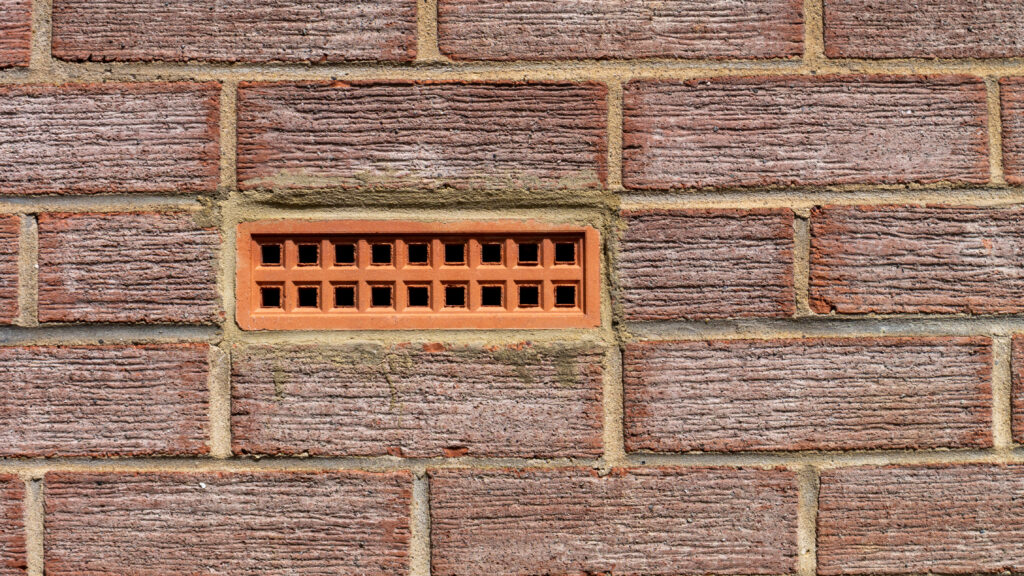A significant proportion of homes in the UK feature suspended timber and concrete ground floors, which require adequate ventilation. During home surveys, it is often observed that subfloor ventilation is unintentionally reduced or blocked by property owners. This can happen for various reasons, such as installing decking, raising external ground levels, or attempting to minimize heat loss within the property.
Subfloor ventilation is a crucial aspect of maintaining the structural integrity, comfort, and overall health of homes. The subfloor area plays a vital role in managing moisture, preventing dampness, and ensuring indoor air quality. In this blog, we will delve into the importance of subfloor ventilation in residential properties.
Mitigating Dampness
One primary role of subfloor ventilation is to mitigate dampness, often caused by moisture build-up in the subfloor area. The UK’s climate, characterized by high humidity and frequent rainfall, makes subfloor ventilation crucial in preventing dampness.
Moisture Control: Subfloor ventilation systems, such as airbricks, vents, and mechanical fans, facilitate the exchange of moist air with drier air from outside the property. This exchange helps reduce moisture levels in the subfloor area, preventing dampness from affecting the structural elements of the house.
Timber Preservation: Damp conditions can lead to the decay of timber floorboards and joists, compromising the structural integrity of the property. Subfloor ventilation plays a vital role in preserving timber elements by keeping them dry and preventing rot and woodworm.
Preventing Rising Damp: Subfloor dampness can contribute to rising damp issues, where moisture travels up through walls. Adequate ventilation helps prevent rising damp, protecting the interior walls from moisture-related problems.
Promoting Structural Integrity
Subfloor ventilation is essential for maintaining the structural integrity of residential properties, especially in older homes where timber and masonry are commonly used. Without proper ventilation, serious structural issues may arise.
Pest Control: Inadequate ventilation can create an environment conducive to pests, including wood-boring insects and rodents. These pests can cause significant damage to timber and other structural elements. Effective subfloor ventilation helps deter infestations, preserving the integrity of the building.
Preventing Mould Growth: Excess moisture in the subfloor area can promote mould growth on surfaces and within structural materials. Mould can pose health risks to occupants. Subfloor ventilation helps prevent mould growth by reducing moisture levels.
Maintaining a Healthy Environment
Subfloor ventilation plays a crucial role in safeguarding the health and well-being of occupants.
Indoor Air Quality: Damp subfloor areas can release airborne contaminants such as mould spores and allergens into the indoor air, leading to respiratory issues, allergies, and other health problems. Proper ventilation helps maintain indoor air quality by reducing the presence of these pollutants.
Radon Gas Mitigation: In some regions of the UK, radon gas can be present in the subsoil. Radon is a radioactive gas that can seep into homes through cracks and gaps in the foundation. Subfloor ventilation systems, including underfloor fans and barriers, can help mitigate radon gas infiltration, reducing the associated health risks.
Thermal Comfort: Subfloor ventilation also contributes to thermal comfort within the home. A dry subfloor area helps prevent cold, damp air from rising into the living spaces, improving overall comfort and reducing heating costs.
Subfloor ventilation is a critical component of residential homes across the UK, serving multiple essential functions. It mitigates dampness, preserving the structural integrity of the building, and safeguards the health of occupants. With an aging housing stock in a climate characterized by high humidity and frequent rainfall, effective subfloor ventilation is a necessity. Property owners and homeowners must prioritize subfloor ventilation to ensure the long-term durability, comfort, and well-being associated with their homes. By recognizing the importance of subfloor ventilation and ensuring adequate ventilation is provided, homeowners can minimize their risk of associated issues from arising.



